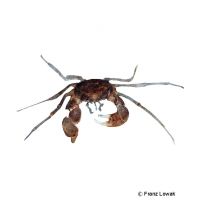Thai Micro Crab (Limnopilos naiyanetri)
| Thai Micro Crab Limnopilos naiyanetri | |
|---|---|
| Name | Thai Micro Crab |
| Name Lat. | Limnopilos naiyanetri |
| Family | False Spider Crabs |
| Family lat. | Hymenosomatidae |
| Order | Decapoda |
| Order lat. | Decapoda |
| Origin | Southeast Asia |
| Habitat | Streams |
| Diet | Algae, detritus, shrimp food |
| pH | 6.0-7.5 |
| Behavior | Peaceful |
| Keeping | Group |
| Care Level | Moderate |
| Reproduction | Egg layer |
| Breeding | Difficult |
| Life Span | 1-2 years |
| Protection | No |
| Metric Units | |
| Size | 1 cm |
| Temperature | 22-28 °C |
| Hardness | 4-15 °dH |
| Aquarium | 20 l |
| US Units | |
| Size | 0.4" |
| Temperature | 72-82 °F |
| Hardness | 71-267 ppm |
| Aquarium | 5 gal |
Distribution and habitat
The distribution area of the purely aquatic microcrabs is in Thailand, where they live in slow-flowing and stagnant waters with floating plants and dense underwater vegetation. There they dwell in fine-leaved underwater plants and the roots of water hyacinths.
Maintenance
They need a partly densely planted aquarium with fine-leaved underwater plants, roots and floating plants (e.g. Eichhornia). A substrate of fine gravel and sand covered with some foliage (e.g. sea almond tree, oak) and mulm and a very weak current is ideal.
No ammonia, ammonium and nitrite should be detectable in the aquarium water, and the nitrate value should not exceed 100 mg/l. To ensure the water quality and oxygen content, a filter and heater adapted to the aquarium size is required, as well as lighting for the species-appropriate day-night rhythm of the animals. When choosing the filter, special care should be taken to ensure that the animals cannot be sucked in.
Diet
It feeds on suspended food particles (zoo and phytoplankton), which they catch with their hairy claws and legs, as well as the smallest insect larvae and detritus. The food supply consists of commercial dry food for shrimps and crabs, supplemented with cyclops, daphnia, microworms, Artemia nauplii, plankton food, etc..
Unaccepted food should be removed after 4-5 hours. A regular and varied diet promotes health and prevents deficiency symptoms
Behaviour and compatibility
These peaceful crabs are very well suited for care in a nano aquarium and should be kept in a group of at least five animals. A socialization with dwarf shrimps, but also with small peaceful fish is well possible
In principle, only mutually compatible animals with similar requirements for water conditions and water temperature should be socialized.
Reproduction and breeding
Due to their size, it is difficult to distinguish the sexes. The females have a wide abdominal flap, which is narrow and pointed in the male.
Larvae have been observed hatching after the female has carried the eggs in her abdominal pocket for several weeks. At present, however, there are no reliable reports that nursing the animals beyond the larval stage has been successful
Important
They are the smallest known crabs with a carapace of about 1 cm.
The foliage (sea almond tree, oak, etc.) enriches the water with humic substances, naturally lowers the pH and, when rotting, promotes the development of microorganisms, which are a valuable secondary food source
The well-being of the animals should be monitored regularly. Temperature should be checked daily, pH, hardness and nitrate levels at least every 14 days. Regular partial water changes are recommended, even when contaminant levels have not yet reached the upper limit. Sudden changes in water quality should be avoided. Newly introduced animals must be accustomed slowly to the water in the aquarium.
Further literature can be found in your pet store.
References
Text: petdata; Image: Franz Lowak
Source: ENGELMANN & LANGE (2011): Zootierhaltung - Tiere in menschlicher Obhut: Wirbellose, Verlag Harri Deutsch
